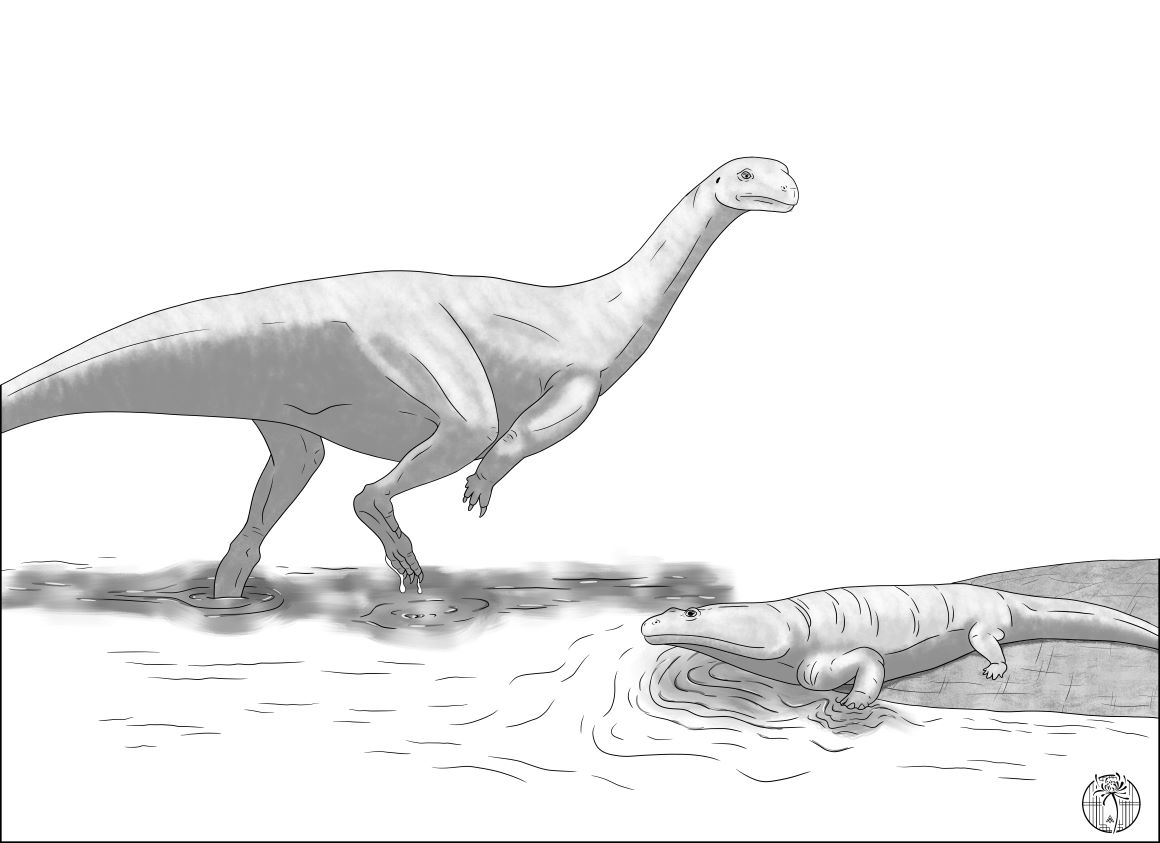An international team of scientists, from Zimbabwe, South Africa and the UK, have unveiled a new dinosaur species discovered from fossils found in Zimbabwe.

Artist reconstruction of Musankwa sanyatiensis, walking in Triassic shallow waters past a metoposaur © Atashni Moopen
- Natural History Museum palaeontologist, Prof. Paul Barrett, describes new species of sauropodomorph dinosaur
- The rocks yielding the new specimen date back to the Late Triassic period
- The new dinosaur is only the fourth ever named from Zimbabwe
An international team of scientists, from Zimbabwe, South Africa and the UK, have unveiled a new dinosaur species discovered from fossils found on the shoreline of Lake Kariba, Zimbabwe. The remarkable find, named Musankwa sanyatiensis, marks only the fourth dinosaur species to have been named from Zimbabwe and is the first to be named from the Mid-Zambezi Basin in over 50 years.
The rocks yielding this new specimen date back to the Late Triassic period, approximately 210 million years ago. Musankwa sanyatiensis is represented by the remains of a single hind leg, including its thigh, shin, and ankle bones.
The fossils of Musanwka were discovered on an expedition to northern Zimbabwe in 2018, when Prof. Paul Barrett, palaeontologist at the Natural History Museum and the study’s lead author, noticed the leg bones sticking out of the ground.
Paul commented: “We were walking along the shoreline when I noticed these leg bones eroding out of the ground. After we excavated the fossils, we realised it was quite different from the dinosaurs you might expect to find in the area.
“I’ve named many species in my career, but this is the first time I’ve described a dinosaur that I found myself.”
The genus name of the new dinosaur honours a boat, named ‘Musankwa’, which was loaned to the research group and served as the team’s home and mobile laboratory. The species name reflects one of the rivers flowing into Lake Kariba, the Sanyati.
Evolutionary analysis reveals that Musankwa sanyatiensis was a member of the Sauropodomorpha, a group of bipedal, long-necked dinosaurs that were widespread during the Late Triassic. Weighing in at around 390kg, roughly the same as a horse, and reaching 1.5 metres at the hip, it would have been one of the larger dinosaurs of its era.
The research team’s evolutionary trees hinted that the new species might be linked to Riojasaurus from Argentina and Eucnemesaurus from South Africa. This may mean these animals were a widespread group of dinosaurs able to move back and forth between what is now South America and southern Africa.
Paul added, “This particular species dates back to the Late Triassic when dinosaurs were getting larger and starting to dominate ecosystems. At this time, they began to become more diverse and spread around the world, making it an important era to investigate.”
Africa has a long history of dinosaur discovery, with the first dinosaur in the southern hemisphere found in South Africa just three years after the term "dinosaur" was coined by Sir Richard Owen in 1842. However, most known dinosaur fossils have been found in ten countries predominantly in the northern hemisphere, leading to a sparse representation of African dinosaur diversity in the global fossil record.
Dr Kimberley ‘Kimi” Chapelle, assistant professor at Stonybrook University and an honorary associate at the Evolutionary Studies Institute of the University of the Witwatersrand, comments: “The main reason for the underrepresentation of African dinosaur fossils is ‘undersampling’. Put simply, there have been fewer people looking for and unearthing dinosaurs in comparison with other regions of the world.
“Based on where it sits on the dinosaur family tree, Musanwka sanyantiensis is the first dinosaur of its kind from Zimbabwe. It therefore highlights the potential of the region for further palaeontological discoveries.”
The study, A new Late Triassic sauropodomorph dinosaur from the Mid-Zambezi Basin, Zimbabwe, is published in the journal, Acta Palaeontologica Polonica, and can be accessed here.
Notes to editors
Assets
Images and study paper available to download here.
Press contact
Natural History Museum Press Office
Tel: +44 (0)20 7942 5654 / 07799690151
Email: press@nhm.ac.uk
The Natural History Museum is a world-leading science centre and one of the most visited attractions in the UK. A global source of curiosity, inspiration and joy.
Our vision is to build a future in which both people and the planet thrive.
We aim to be a catalyst for change, engaging advocates for the planet in everything that we do. Our 350 scientists are finding solutions to the planetary emergency in all aspects of life.
Visit, join and support the Natural History Museum today. Protecting the planet. It's in our nature.
Contact
Weekdays: +44 (0)20 7942 5654
Evenings and weekends:
+44 (0)7799 690 151
Email: press@nhm.ac.uk
Don't miss a thing
Receive email updates about our news, science, exhibitions, events, products, services and fundraising activities. We may occasionally include third-party content from our corporate partners and other museums. We will not share your personal details with these third parties. You must be over the age of 13. Privacy notice.
Follow us on social media